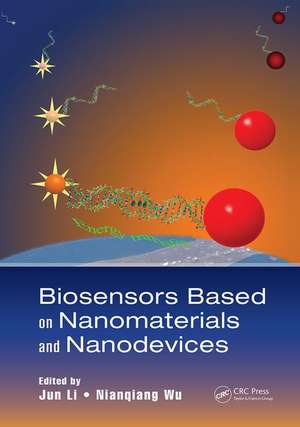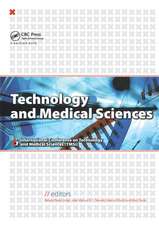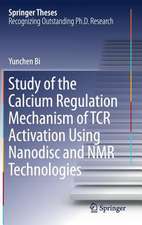Biosensors Based on Nanomaterials and Nanodevices: Nanomaterials and their Applications
Editat de Jun Li, Nianqiang Wuen Limba Engleză Paperback – 29 mar 2017
- Explains how to utilize the unique properties of nanomaterials to construct nanostructured biosensors to achieve enhanced performance
- Features examples of biosensors based on both typical and emerging nanomaterials, such as gold nanoparticles, quantum dots, graphene, graphene oxides, magnetic nanoparticles, carbon nanotubes, inorganic nanowires/nanorods, plasmonic nanostructures, and photonic crystals
- Demonstrates the broad applications of nanostructured biosensors in environmental monitoring, food safety, industrial quality assurance, and in vitro and in vivo health diagnosis
- Inspires new ideas for tackling multiscale and multidisciplinary issues in developing high-performance biosensors for complex practical biomedical problems
| Toate formatele și edițiile | Preț | Express |
|---|---|---|
| Paperback (1) | 456.63 lei 6-8 săpt. | |
| CRC Press – 29 mar 2017 | 456.63 lei 6-8 săpt. | |
| Hardback (1) | 1192.34 lei 6-8 săpt. | |
| CRC Press – 20 dec 2013 | 1192.34 lei 6-8 săpt. |
Preț: 456.63 lei
Preț vechi: 590.26 lei
-23% Nou
Puncte Express: 685
Preț estimativ în valută:
87.37€ • 91.47$ • 72.30£
87.37€ • 91.47$ • 72.30£
Carte tipărită la comandă
Livrare economică 05-19 aprilie
Preluare comenzi: 021 569.72.76
Specificații
ISBN-13: 9781138073258
ISBN-10: 1138073253
Pagini: 518
Ilustrații: 217
Dimensiuni: 178 x 254 mm
Greutate: 0.45 kg
Ediția:1
Editura: CRC Press
Colecția CRC Press
Seria Nanomaterials and their Applications
ISBN-10: 1138073253
Pagini: 518
Ilustrații: 217
Dimensiuni: 178 x 254 mm
Greutate: 0.45 kg
Ediția:1
Editura: CRC Press
Colecția CRC Press
Seria Nanomaterials and their Applications
Cuprins
Opportunities and Challenges of Biosensors Based on Nanomaterials and Nanodevices. Synthesis and Characterization of Quantum Dots. Quantum Dots for Bioimaging. Fluorescent Sensors Based on Energy Transfer and Charge Transfer. Graphene-Based Optical Biosensors and Imaging. Biosensing Based on Surface-Enhanced Raman Spectroscopy. In Vivo Biodetection Using Surface-Enhanced Raman Spectroscopy. Photonic Crystal Biosensors. Nanomaterial-Based Electrochemiluminescence Biosensors. Nanocrystalline Diamond Biosensors. Carbon Nanotube-Based Electrochemical Biosensors. Vertically Aligned Carbon Nanofibers for Biointerfacing. Graphene-Based Electrochemical Biosensors. Bioelectronics on Graphene. Nanowire Field-Effect Transistor Biosensors. Biosensing and Cancer Treatment with Magnetic Nanoparticles. Solid-Liquid Phase Change Nanoparticles as Thermally Addressable Biosensors. Microfluidic and Lab-on-Chip Technologies for Biosensors.
Recenzii
"Biosensors Based on Nanomaterials and Nanodevices explains the essential technologies in nanotube-combined biosensors. From the optical biosensors using nanoscale materials, the book covers very recent technologies, including electrical, magnetic, and thermal biosensors. The concise theories of each sensor platform provide a good introduction for a general audience with a background at the university level. Readers can find information about optical biosensors using nanomaterials and nanodevices in the first section of the book. The optical methods have been studied extensively because of their high potential for biosensing applications. These methods have the advantages of reliability, sensitivity, selectivity, and applicability for in vivo detection, and an extensive discussion is included in the text. In the beginning of the section, the fundamental theories and techniques provide a guideline for beginning scholars, and, using the plasmonic nanomaterials, the surface-enhanced Raman spectroscopy techniques are intensively introduced. Furthermore, photonic crystals and electroluminescence sensor platforms are explained with a new concept of the future biosensors. In the second section, electrical biosensors are reviewed with novel nanomaterials such as diamond, carbon nanotubes, graphene, and inorganic semiconductor nanowires. The electrical techniques are also widely developed because they are suitable for handheld electronic devices. Using nanomaterials allows for the enhancement of the sensor characteristics, and novel applications, such as neuron interfacing and cellular detection, are enabled. Recent advances on these techniques with well-established theories and examples are found in this book. Nanomaterials are being developed not only for the detection but for in vivo treatment. Magnetic nanoparticles are described in the third section, including synthesis and applications. Readers can find recent information about bioseparation, drug delivery, and hyperthermia treatment using these particles. In the final section, other new concepts of nanoscale platforms are introduced, such as multiplexed detection using thermally addressable biosensors and microfluidics for biosensor applications. The book provides excellent information on well-established and emerging techniques to readers who are interested in next-generation biosensor platforms. It has fulfilled the need to provide information on nanomaterial-based sensors with substantial theory. As a nanoscale semiconductor biosensor engineer, I recommend this book to colleagues and students."
--Taiuk Rim, IEEE Nanotechnology Magazine, September 2014
--Taiuk Rim, IEEE Nanotechnology Magazine, September 2014
Notă biografică
Jun Li holds a PhD in chemistry from Princeton University, New Jersey, USA. A recipient of NASA Tech Briefs’ Nano50 Innovator Award, he has engaged in research at Cornell University, Ithaca, New York, USA; Molecular Imaging Inc., Ann Arbor, Michigan, USA; Institute of Materials Research and Engineering, Singapore; NASA Ames Research Center, Mountain View, California, USA; and Kansas State University, Manhattan, USA—where he currently serves as professor. A co-inventor of 15 patents and an associate editor for IEEE Transactions on Nanotechnology, he has published 120 peer-reviewed papers/book chapters and his work has been highlighted in over 40 news reports.
Nianqiang (Nick) Wu currently serves as associate professor for West Virginia University, Morgantown, USA; secretary of the Electrochemical Society’s Sensor Division; and advisory board member for Interface, the home journal of the Electrochemical Society. He holds a PhD in materials science and engineering from Zhejiang University, Hangzhou, People’s Republic of China. Previously he was a postdoctoral fellow at University of Pittsburgh, Pennsylvania, USA and directed Keck Surface Science Center at Northwestern University, Evanston, Illinois, USA. He has organized several symposia on biosensors and solar fuels, holds four patents/disclosures, and has published three book chapters and more than 110 journal papers.
Nianqiang (Nick) Wu currently serves as associate professor for West Virginia University, Morgantown, USA; secretary of the Electrochemical Society’s Sensor Division; and advisory board member for Interface, the home journal of the Electrochemical Society. He holds a PhD in materials science and engineering from Zhejiang University, Hangzhou, People’s Republic of China. Previously he was a postdoctoral fellow at University of Pittsburgh, Pennsylvania, USA and directed Keck Surface Science Center at Northwestern University, Evanston, Illinois, USA. He has organized several symposia on biosensors and solar fuels, holds four patents/disclosures, and has published three book chapters and more than 110 journal papers.
Descriere
Linking leading interdisciplinary research, this book provides a comprehensive source for key advancements and future trends in nanostructured biosensor development. It describes the concepts, principles, materials, device fabrications, functions, system integrations, and applications of various biosensors based on signal transduction mechanisms; explains how to utilize the unique properties of nanomaterials to construct nanostructured biosensors to achieve enhanced performance; includes examples of biosensors based on both typical and emerging nanomaterials; and inspires new ideas for tackling multiscale and multidisciplinary issues in the development of high-performance biosensors.






















